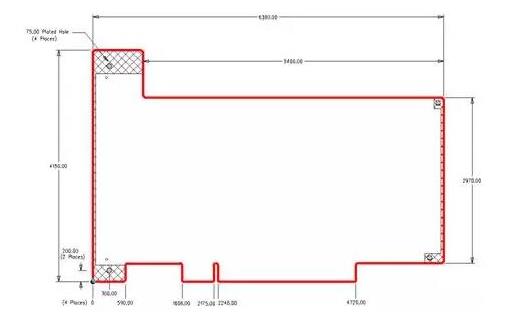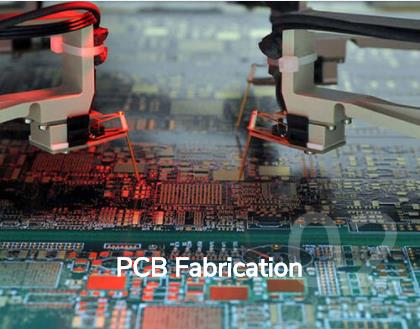The complete PCB board we envision is usually a regular rectangular shape. While it is true that most designs are rectangular, many require irregularly shaped boards, which are often difficult to design. This article describes how to design irregularly shaped PCB boards. Today's PCB boards are shrinking in size, and there are more and more functions in the circuit board, which, coupled with increasing clock speeds, makes designs more complex. So, let's take a look at what to do with boards with more complex shapes. However, when the board form factor needs to fit into a complex enclosure with height constraints, it is not so easy for the PCB board designer because the functionality in these tools is not the same as that of a mechanical CAD system. Complex circuit boards are mainly used in explosion-proof enclosures and are therefore subject to numerous mechanical limitations. Trying to reconstruct this information in an EDA tool can take a long time and is not productive. Because there is a good chance that the mechanical engineer has created the enclosure, board form factor, mounting hole locations, and height constraints that the PCB board designer needs. These are just a few examples of complex circuit board profiles. However, from today's consumer electronics, you'd be surprised how much engineering is trying to pack all the functionality into a small package that isn't always rectangular. You should be thinking of smartphones and tablets, but there are many similar examples. If you're returning a rental car, you might be able to see the attendant reading the car's information with a handheld scanner and then wirelessly communicating with the office. The device is also connected to a thermal printer for instant receipt printing. In fact, all of these devices employ rigid/flex circuit boards, where conventional PCB boards are interconnected with flexible printed circuits so that they can be folded into small spaces. The question, then, is "how to import defined mechanical engineering specifications into a PCB board design tool?" Reusing this data in mechanical drawings eliminates duplication of effort and, more importantly, human error. We can solve this problem by importing all the information into the PCB board layout software using DXF, IDF or ProSTEP format. Doing so saves a lot of time and eliminates possible human error. Next, we'll take a look at these formats one by one.

Graphics Interchange Format - DXF
DXF is a long-established and widely used format for exchanging data between the mechanical and PCB design domains primarily electronically. AutoCAD developed it in the early 1980s. This format is mainly used for two-dimensional data exchange. Most PCB board tool suppliers support this format, and it does simplify data exchange. DXF import/export requires additional functionality to control the layers, different entities and elements that will be used in the exchange process. Figure 5 is an example of using Mentor Graphics' PADS tool to import a very complex board shape in DXF format: a few years ago, 3D capabilities began to appear in PCB board tools, so there was a need for a way to bridge the gap between mechanical and PCB board tools. The format in which 3D data is transmitted. From this, Mentor Graphics developed the IDF format, which has since been widely used to transfer board and component information between PCB boards and machine tools. While the DXF format includes board dimensions and thickness, the IDF format uses the component's X and Y position, component tag number, and component's Z-axis height. This format greatly changes the ability to visualize PCB boards in 3D views. Additional information about the no-go area may also be included in the IDF file, such as height restrictions on the top and bottom of the board. The system needs to be able to control what will be included in the IDF file in a similar way to DXF parameter settings. If some components do not have height information, IDF export can add the missing information during the creation process.
Another advantage of the IDF interface is that either party can move components to new locations or change the shape of the board and then create a different IDF file. The downside of this approach is that the entire file representing board and component changes needs to be re-imported, and in some cases can take a long time due to file size. Also, it can be difficult to determine what changes have been made with the new IDF file, especially on larger boards. Users of IDF can eventually create custom scripts to determine these changes.

STEP and ProSTEP
In order to better transmit 3D data, designers are looking for an improved way, and STEP format came into being. The STEP format can convey board dimensions and component placement, but more importantly, components are no longer a simple shape with only a height value. The STEP component model provides a detailed and complex representation of components in 3D. Both board and component information can be transferred between the PCB and the machinery. However, there is still no mechanism by which changes can be tracked. To improve STEP file exchange, we have introduced the ProSTEP format. This format moves the same data as IDF and STEP, with great improvements - it can track changes as well as provide the ability to work in the discipline's original system and review any changes after a baseline has been established. In addition to reviewing changes, PCB board and mechanical engineers can approve all or individual component changes in layout, board outline modifications. They can also suggest different board sizes or component placement. This improved communication creates an ECO (Engineering Change Order) between ECAD and the mechanical group that never existed before. Most ECAD and mechanical CAD systems now support the use of the ProSTEP format to improve communication, saving a lot of time and reducing costly errors that can come with complex electromechanical designs. What's more, engineers can save time by creating a complex board profile with additional constraints and then communicating this information electronically to avoid someone mistakenly reinterpreting board dimensions.
Summarize
If you have not used these DXF, IDF, STEP or ProSTEP data formats to exchange information, you should check their usage. Consider using this electronic data interchange to stop wasting time recreating complex PCB board profiles.